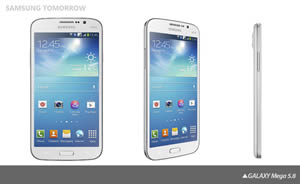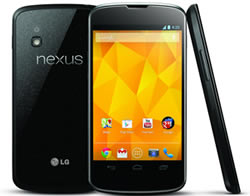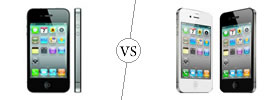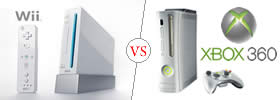Difference between Samsung Galaxy Mega 5.8 and Nexus 4
Key difference: Samsung has now expanded its’ offerings in the phablet category by introducing the Samsung Galaxy Mega 5.8 and Samsung Galaxy Mega 6.3. The Samsung Galaxy Mega 5.8 is named such because of its 5.8 inch TFT capacitive touchscreen, with a resolution of 540 x 960 pixels. The phone is powered by a Dual-core 1.4 GHz processor with a 1.5 GB RAM. The Nexus 4 is Google's fourth Nexus-branded Android smartphone. It was produced in collaboration with LG Electronics. The phone features a 1.5 GHz quad-core Snapdragon S4 Pro processor and 2 GB of RAM.

Samsung is a major player on the world smartphone platform. It is the second most popular smartphone retailer in the world by number of units sold, after Apple. It is in fact the first most popular Android smartphone retailer in the world by number of units sold. The company’s Samsung Galaxy S3 was the first phone that gave the iPhone a real competition. Hence, effectively making the Galaxy brand, a brand to be reckoned with.
Samsung is also credited with creating the ‘phablet’ category by introducing the Samsung Galaxy Note. A phablet is a cross between a phone and a tablet; it sized as a table but with all the properties of a phone. Samsung has now expanded its’ offerings in the phablet category by introducing the Samsung Galaxy Mega 5.8 and Samsung Galaxy Mega 6.3.
The Samsung Galaxy Mega 5.8 is named such because of its 5.8 inch TFT capacitive touchscreen, with a resolution of 540 x 960 pixels. The phone is powered by a Dual-core 1.4 GHz processor with a 1.5 GB RAM. The phone runs Android 4.2.2, the latest version of Android at the time of its launch. The phone also features an 8 MP primary camera and a 1.9 MP secondary front-facing camera.
In addition to the above mentioned features, the phone also boasts several features that are available on the Samsung Galaxy S4. This includes ‘Group Play’, which enables easy content sharing for up to 8 devices on the same Wi-Fi network; ‘Samsung WatchON’ that transforms the phone into an IR remote controller to connect to the home entertainment system; ‘Samsung Link’ for streaming photos, videos, notes, or music to the television, tablet or computer; ‘S Translator’ that provides instant translation, using text or voice translation on applications including email, and ChatON, which allows the user to share the phone’s screen with other users.
Furthermore, the phone also has a split screen capability that allows two or more applications to share the screen. These applications include email, messages, ‘MyFiles,’ ‘S Memo,’ ‘S Planner’, and more. The phone also has the popular ‘Air View’ feature, which allows users to preview information in emails, photos in Gallery, and speed dial contacts, before opening them. In addition, the ‘S Travel’ feature trip information, local guides and resources, etc., while the ‘Story album’ allows users to create albums of daily events, keep special moments in one place using a timeline, geo-tag information and publish digital albums in hard copy.

Among the number of various companies, Google has also launched its own line of smartphones based on Android, called the Google Nexus. Each device in the Nexus line is produced via collaboration between Google and a leading original equipment manufacturer (OEM) partner.
The Nexus devices in general have an advantage over other devices in that the Android in the Nexus devices is pure. I.e. the Android does not have any manufacturer or wireless carrier modifications to it, such as a custom graphical user interface. The Android also has an unlockable bootloader to allow further development and end-user modification, all of which is usually blocked on other Android smartphones.
The Nexus 4 is Google's fourth Nexus-branded Android smartphone. It was produced in collaboration with LG Electronics. The phone features a 1.5 GHz quad-core Snapdragon S4 Pro processor, 2 GB of RAM, 8 or 16 GB of internal storage, front facing 1.3 megapixel camera and an 8 megapixel rear camera and a micro-SIM card tray. The phone runs on the Android 4.2 (Jelly Bean) operating system, which was launched with the phone. The phone also features a new camera technology, called the Photo Sphere. This allows one to take 360 deg Panorama shots.
The information for the detailed table about the two phones has been taken from the Google Nexus website, samsungmobilepress.com, samsungtomorrow.com, gdgt.com and GSMarena.com.
|
|
Samsung Galaxy Mega 5.8 |
Nexus 4 |
|
Launch Date |
May 2013 |
November 13, 2012 |
|
Company |
Samsung |
Google; designed in collaboration with and manufactured by LG Electronics. |
|
Size |
162.6 x 82.4 x 9 mm (6.40 x 3.24 x 0.35 in) |
133.9 x 68.7 x 9.1 mm (5.27 x 2.70 x 0.36 in) |
|
Display |
TFT capacitive touchscreen |
True HD IPS Plus capacitive touchscreen, 16M colors |
|
Screen |
540 x 960 pixels, 5.8 inches (~190 ppi pixel density) |
768 x 1280 pixels, 4.7 inches (~318 ppi pixel density) |
|
Protection |
- |
Corning Gorilla Glass 2 |
|
Weight |
182 g (6.42 oz) |
139g (4.90 oz) |
|
2G Network |
GSM 850 / 900 / 1800 / 1900 - GT-I9150 GSM 850 / 900 / 1800 / 1900 - GT-I9152 (SIM 1 & SIM 2) |
GSM 850 / 900 / 1800 / 1900 |
|
3G Network |
HSDPA |
HSDPA 850 / 900 / 1700 / 1900 / 2100 |
|
4G Network |
No |
No |
|
GUI |
TouchWiz UI |
Pure Android |
|
CPU speed |
Dual-core 1.4 GHz |
Quad-core 1.5 GHz Krait |
|
GPU |
- |
Adreno 320 |
|
OS |
Android OS, v4.2.2 (Jelly Bean) |
Android OS, v4.2 (Jelly Bean), upgradable to v4.2.2 (Jelly Bean) |
|
Chipset |
TBA |
Qualcomm APQ8064 Snapdragon |
|
RAM |
1.5 GB RAM |
2 GB RAM |
|
SIM Size |
TBA - Optional Dual SIM |
Micro-SIM |
|
Internal Memory |
8 GB |
8/16 GB storage |
|
Expandable Memory |
microSD, up to 64 GB |
None |
|
Sensors |
Accelerometer, Geomagnetic, Proximity, Light, Gyroscope |
Accelerometer, gyro, proximity, compass, barometer |
|
Connectivity |
|
|
|
Data |
GPRS, EDGE, WLAN, Bluetooth, USB |
WiFi, NFC, GPRS, EDGE, USB |
|
Speed |
HSDPA, 21 Mbps; HSUPA, 5.76 Mbps |
DC-HSDPA, 42 Mbps; HSDPA, 21 Mbps; HSUPA, 5.76 Mbps |
|
WLAN |
Wi-Fi 802.11 a/b/g/n, dual-band, Wi-Fi Direct, Wi-Fi hotspot |
Wi-Fi 802.11 a/b/g/n, dual-band, DLNA, Wi-Fi hotspot |
|
Bluetooth |
Yes, v4.0 with A2DP, LE |
Bluetooth v4.0 with A2DP |
|
USB |
No |
microUSB (SlimPort) v2.0 |
|
Primary Camera |
8 MP, 3264 x 2448 pixels, autofocus, LED flash |
8 MP, 3264 x 2448 pixels, autofocus, LED flash |
|
Secondary Camera |
1.9 MP |
1.3 MP |
|
Video |
Yes, 1080p@30fps |
1080p@30fps |
|
Camera Features |
autofocus, LED flash, Geo-tagging, touch focus, face and smile detection, Beauty Face, Best Photo, Best Face, Drama, Rich Tone (High Dynamic Range), Sound & Shot, Sports, Continuous shot |
Touch focus, geo-tagging, face detection, photo sphere |
|
Sound Enhancement |
- |
SNS integration Active noise cancellation with dedicated mic |
|
Audio supported formats |
MP3, M4A, AAC, OGG, OGA, WAV, WMA, AMR, AWB, FLAC, MID, MIDI, XMF, MXMF, IMY, RTTTL, RTX, OTA |
MP3/WAV/eAAC+/AC3 player |
|
Video supported formats |
MP4, M4V, 3GP, 3G2, WMV, ASF, AVI, FLV, MKV, WEBM |
MP4/H.264/H.263 player |
|
Battery Capacity |
Li-Ion 2600 mAh battery |
Non-removable Li-Po 2100 mAh battery |
|
Available Colors |
White, Black |
Black |
|
Messaging |
SMS(threaded view), MMS, Email, Push Mail, IM, RSS |
SMS(threaded view), MMS, Email, Push Mail, IM, RSS |
|
Browser |
HTML5 |
HTML5 |
|
Radio |
No |
No |
|
GPS |
Yes, with A-GPS support and GLONASS |
with A-GPS support and GLONASS |
|
Java |
Yes, via Java MIDP emulator |
Java MIDP emulator |
|
Additional Features |
|
|
Image Courtesy: samsungtomorrow.com, blogs.computerworld.com









Add new comment